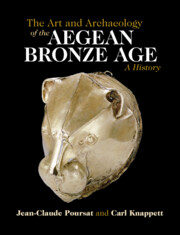Book contents
- The Art and Archaeology of the Aegean Bronze Age
- The Art and Archaeology of the Aegean Bronze Age
- Copyright page
- Contents
- Figures
- Introduction
- Part I Aegean Neolithic Art
- Part II The Art of the Aegean Early Bronze Age
- Part III Aegean Art in the Cretan First Palace Period
- Part IV Aegean Art in the Second Palace Period
- Part V Aegean Art in the Cretan Second Palace Period
- Part VI Aegean Art in the Final Palatial Period of Knossos
- Chapter 33 Artworks in Context
- Chapter 34 Architecture
- Chapter 35 The Frescoes
- Chapter 36 Metalwork, Jewellery, and Various Ornaments
- Chapter 37 Creto-Mycenaean Glyptic in LM II/LH IIB–IIIA1
- Chapter 38 Other Relief Arts
- Chapter 39 Artworks in the Round
- Chapter 40 LM II/LH IIB–IIIA1 Pottery
- Part VII Aegean Art of the Mainland Mycenaean Palatial Period
- Part VIII Aegean Art at the End of the Bronze Age
- Afterword Aegean Art Through Forgers’ Eyes
- References
- Index
- Plate Section (PDF Only)
- References
Chapter 39 - Artworks in the Round
Figurines and Zoomorphic Vessels
from Part VI - Aegean Art in the Final Palatial Period of Knossos
Published online by Cambridge University Press: 19 May 2022
- The Art and Archaeology of the Aegean Bronze Age
- The Art and Archaeology of the Aegean Bronze Age
- Copyright page
- Contents
- Figures
- Introduction
- Part I Aegean Neolithic Art
- Part II The Art of the Aegean Early Bronze Age
- Part III Aegean Art in the Cretan First Palace Period
- Part IV Aegean Art in the Second Palace Period
- Part V Aegean Art in the Cretan Second Palace Period
- Part VI Aegean Art in the Final Palatial Period of Knossos
- Chapter 33 Artworks in Context
- Chapter 34 Architecture
- Chapter 35 The Frescoes
- Chapter 36 Metalwork, Jewellery, and Various Ornaments
- Chapter 37 Creto-Mycenaean Glyptic in LM II/LH IIB–IIIA1
- Chapter 38 Other Relief Arts
- Chapter 39 Artworks in the Round
- Chapter 40 LM II/LH IIB–IIIA1 Pottery
- Part VII Aegean Art of the Mainland Mycenaean Palatial Period
- Part VIII Aegean Art at the End of the Bronze Age
- Afterword Aegean Art Through Forgers’ Eyes
- References
- Index
- Plate Section (PDF Only)
- References
Summary
On Crete this is a period of development and transformation in figurines, under the influence of Knossian workshops. Since the previous period, Mesara workshops were making some figurines partly on the wheel, with a cylindrical lower part. It is this type of construction that becomes widespread after 1450 bc, at the expense of the naturalistic-type figurines (Rethemiotakis 2001, 10–18). If some still keep a stepped lower body, a simplified representation of a flounced skirt (AE2, fig. 148; Popham 1984, pl. 191a), most now have a strictly cylindrical base; torso and face are highly stylised, except with some rare exceptions like a head from Psychro with eyes carefully outlined (Rethemiotakis 2001, fig. 21). These figurines are made from separate parts, inserted one into the other or joined (skirt, torso, face, limbs). The torso is still solid, at least on the biggest ones.
- Type
- Chapter
- Information
- The Art and Archaeology of the Aegean Bronze AgeA History, pp. 379 - 382Publisher: Cambridge University PressPrint publication year: 2022

